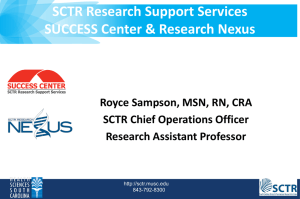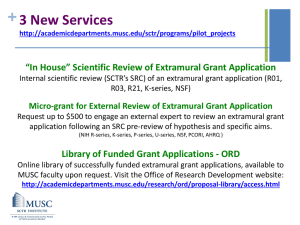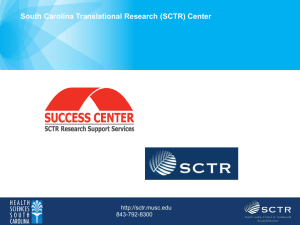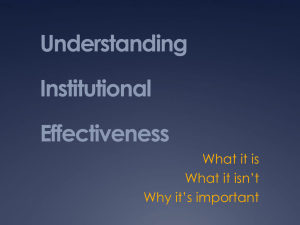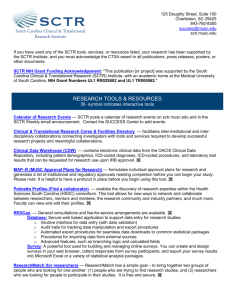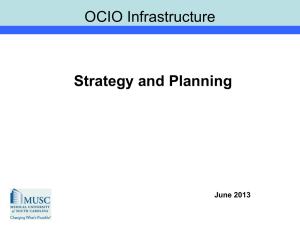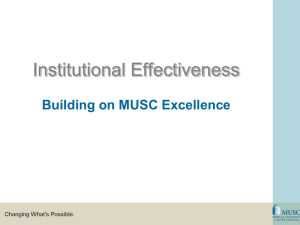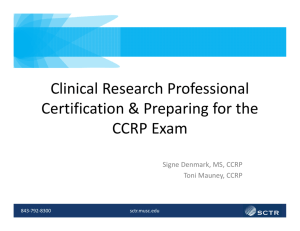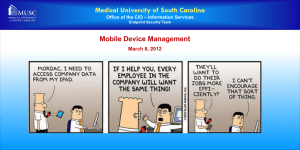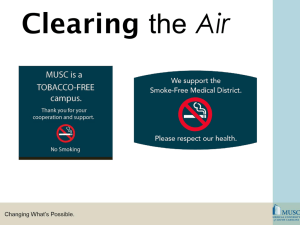Duke Endowment meeting - Technology Applications Center for
advertisement
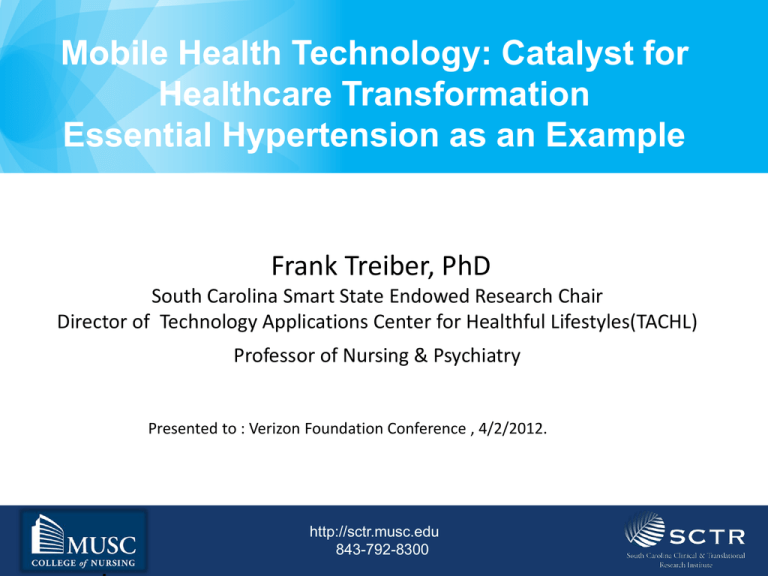
Mobile Health Technology: Catalyst for Healthcare Transformation Essential Hypertension as an Example Subtitle Frank Treiber, PhD Presenters South Carolina Smart State Endowed Research Chair Director of Technology Applications Center for Healthful Lifestyles(TACHL) Date Professor of Nursing & Psychiatry Presented to : Verizon Foundation Conference , 4/2/2012. http://sctr.musc.edu 843-792-8300 Rationale for three interrelated community based projects • Essential hypertension (EH) impacts 33% of US adults • EH is a significant risk factor for CVD, heart attack, stroke, renal failure • Antihypertensive meds. control EH and decrease CVD events • Medication nonadherence is leading contributor to uncontrolled EH • Among EH patients, nonadherence highest among Hispanics and African Americans in underserved areas • Practical, sustainable adherence and BP management programs needed http://sctr.musc.edu 843-792-8300 Rationale contd. • Reviews of clinical trials indicate the following improve medication adherence and BP control: Self monitoring of BP Medication reminder tactics Pharmacist /nurse educational & motivational programs Effects usually deteriorate following cessation of program Comprehensive, acceptable and sustainable patient centered program has not been developed http://sctr.musc.edu 843-792-8300 Proof of Concept Study Design and Methods Subjects: 3 adult prehypertensives (SBP > 120 mmHg) Procedures: Received Tension Tamer, asked to practice 10 minute sessions 2x a day for 3-months Measures collected at preintervention 1, 2, and 3 months: -Resting Hemodynamics and 24-Hour Ambulatory BP -Overnight Urine Sample -Awakening response saliva sampling http://sctr.musc.edu 843-792-8300 Tension Tamer Heart Rate Acquisition http://sctr.musc.edu 843-792-8300 Tension Tamer Results http://sctr.musc.edu 843-792-8300 Proof of Concept Results Reductions in Salivary Alpha-Amylase awaking curve (Marker of SNS activity) from pre to post 3 month intervention. Dose-Response Reductions in 24 hour Ambulatory Blood Pressure. Reductions corresponded with Tension Tamer Adherence rates. http://sctr.musc.edu 843-792-8300 Proposed Feasibility Study Design and Methods Subjects: 60 stage 2 preEH adults (SBP 130-139 mmHg) Procedures: Random assignment to Tension Tamer or standard of care 6 months Measures collected at preintervention 1, 3, 6, and 12 months: -Resting Hemodynamics and 24-Hour Ambulatory BP -Overnight Urine Sample -Repeated saliva sampling http://sctr.musc.edu 843-792-8300 Rationale contd. • mHealth technology enables opportunity to integrate these tactics and help: Patients establish self management skills Patients avoid frequent office visits/check ups, etc. Providers deliver care in more timely manner Facilitate communication between providers & patients Establish and sustain BP control http://sctr.musc.edu 843-792-8300 Preparatory Findings • Key Informant Interviews FQHC patients (21 minorities, mean age: 34.5 yrs.) 29% had uncontrolled EH None had taken meds. in 1 yr. (reasons: poor planning; forgetfulness) 95% owned cell phones (20% had smart phones) All highly receptive to using mHealth technology for med. adherence, BP monitoring, linkage to doctor & fewer trips to clinic http://sctr.musc.edu 843-792-8300 Preparatory Findings Contd. • Mini Proof of Concept Study Purpose: Determine acceptability of the mobile tech. system to patients and providers 4 uncontrolled EH FQHC patients (2 Standard of Care [SOC] , 2 SMASH) for 3 months. http://sctr.musc.edu 843-792-8300 mHealth Technology MedMinder MedMinder Processing Center Medication Reminder Device Microsoft HealthVault Alert Indicators Flashing Light Chime Cell phone call AND BP Monitor Adherence Coach Android Phone Healthcare Provider http://sctr.musc.edu 843-792-8300 Preparatory Findings Contd. • SMASH Results: High levels of patient & provider acceptability; 95-100% med. & BP adherence rates; High desire to continue SMASH; Large, sustained BP reductions; EH became controlled http://sctr.musc.edu 843-792-8300 Ambulatory SBP Changes at 3 months 0.00 Change in SBP (mmHg) -1.25 -5.00 -10.00 SMASH -13.58 -15.00 -20.00 -18.85 -20.53 -25.00 WAKE SLEEP SOC Resting SBPs at Clinic 160 154.17 Systolic BP (mmHg) 150 140 -14.83 SMASH 130 -25.33 -26.67 120 0 1 2 Month 3 SMASH Time Table • • • • • Months 1-3: Focus Groups & Key Informant Interviews: Refine SMASH (e.g., motivational /reinforcement messages, educational messages /video clips; feedback reports) Months 4-6: Complete software programming based upon above findings Months 7-12: 3 month SMASH vs. SOC pilot clinical trial (16 EHs from 2 FQHCs) Months 13-15: Statistical analyses, follow-up focus groups for SMASH refinement Months 16-24: 6 month feasibility clinical trial (48 EHs from 6 FQHCs) http://sctr.musc.edu 843-792-8300 Months 7-12: SMASH Pilot Trial: Design & Methods • Subjects: 16 uncontrolled EH, AAs and Hispanics • Procedures: Random assignment by FQHC to MedMinder/BP system vs. SOC for 3 months Smart phones used for signal transfer and patient – provider linkage Provider summary reports bi-monthly; immediate alerts when beyond thresholds Measurements at pre-treatment, 1, 2 and 3 months (resting hemodynamics, 24hr Ambulatory BP) http://sctr.musc.edu 843-792-8300 Months 16-24: SMASH Feasibility Trial: Design & Methods • Subjects: 48 uncontrolled EH, AAs and Hispanics • Procedures: 6 FQHCs (8 uncontrolled EHs per clinic) Random assignment by FQHC to SMASH vs. SOC for 6 months Measurements at pre-treatment, 3 and 6 months http://sctr.musc.edu 843-792-8300 Rationale • ESRD afflicts more than 500,000 people in the USA • HTN and DM are the #1 and #2 causes of ESRD • Kidney transplantation is the treatment of choice for ESRD • Kidneys are an incredibly scarce resource which mandates that their use be optimized • Despite significant advances, average graft survival is suboptimal at approximately 9 years • Graft survival is worse among African-Americans and those of lower socioeconomic status http://sctr.musc.edu 843-792-8300 Rationale • Medication nonadherence is key contributor to premature graft loss • Approximately 35% of renal transplant patients are nonadherent and issues often develop within weeks of transplantation • Medication nonadherence contributes to graft loss by allowing for immune mediated rejection and the deleterious effects of poorly controlled HTN and DM • Mobile health technology has the potential to improve medication adherence, blood pressure and blood sugar control, and graft survival http://sctr.musc.edu 843-792-8300 Aim • Utilize wireless technology to identify nonadherent patients early after transplant and to interact with them in real time to improve adherent behaviors as a means to improve: • Medication adherence • Control of HTN • Control of DM • Graft survival http://sctr.musc.edu 843-792-8300 Study Design and Methods • Type: Randomized control trial • Subjects: 20 nonadherent kidney transplant patients • Methods: randomly assigned to: • Group A: standard post operative care • Group B: “bundled” wireless real time medication reminder system, blood pressure/blood glucose monitoring, cognitive behavior adherence skills enhancement program http://sctr.musc.edu 843-792-8300 Study Design and Methods • Technology • Maya MedMinder to monitor and aid in medication adherence • Bluetooth enabled Fora D15b to measure and record BP and blood glucose • “Smart” phones for signal transmission • “Smart” phones for patient interaction • Cognitive behavioral enhancement techniques via video conferencing with adherence coach http://sctr.musc.edu 843-792-8300 Study Design and Methods • Outcomes (measured pre-, 1, 2, and 3 months): • Medication adherence (Maya MedMinder) • Blood pressure control (Fora D15b, 24h ambulatory BP) • Blood glucose control (Fora D15b, HgbA1c) • Immunosuppression (FK506 variability) http://sctr.musc.edu 843-792-8300 Rationale •Essential hypertension (EH) impacts 33% of US adults, higher prevalence among African Americans (AAs). • EH is a significant risk factor for CVD, heart attack, stroke, renal failure. • Leading predictor of EH is preEH (SBP/DBP 121-139/81-89 mmHg) • Sustainable/easily disseminated prevention programs needed • Breathing meditation shown to reduce BP among EH and preEH AA patients • Smartphones enable large-scale/easy dissemination http://sctr.musc.edu 843-792-8300
